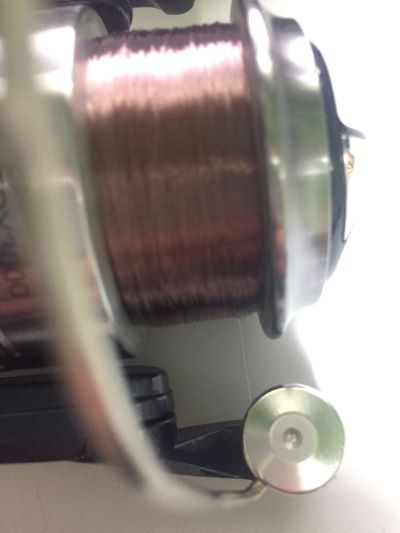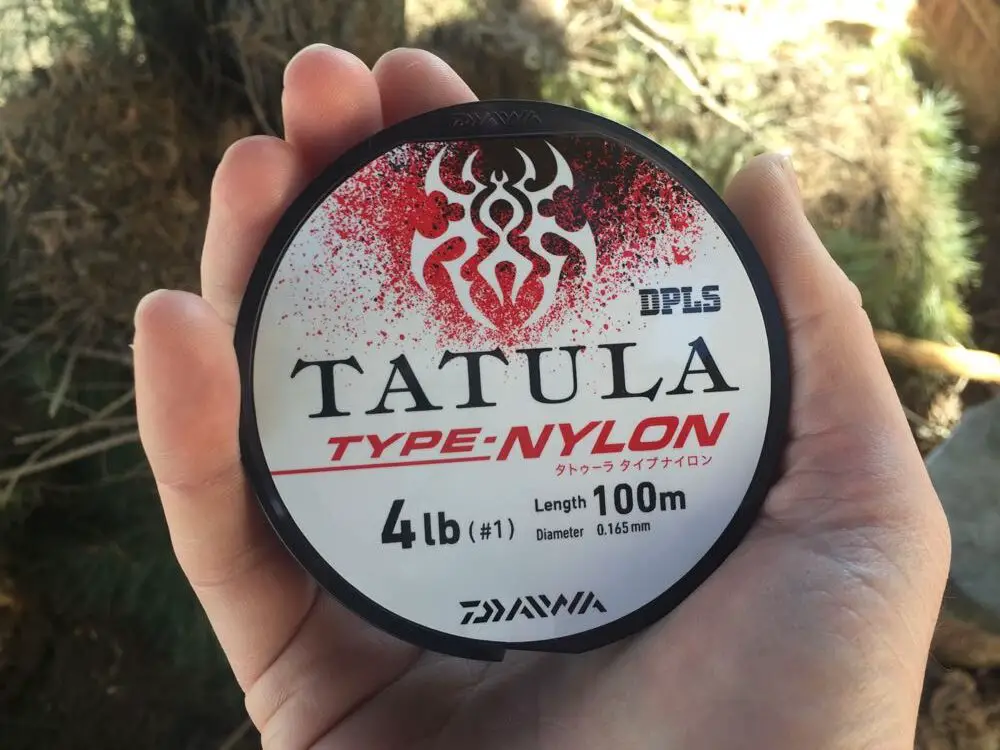The breaking strain of fishing line most suitable for targeting trout in streams and ponds is 4lb, with a diameter of 0.008″ (0.20mm). This thin line is difficult for the trout to see and casts further when fishing with typical trout spinners. When fishing rivers, going up to 6lb or 8lb line is sometimes required.
When targeting larger trout some anglers prefer to fish with 6lb line (0.009″ (0.23mm). This heavier line reduces the chance of trout breaking off. In general, the thicker the line the easier it is for the trout to sense and can easily be the cause of a trout refusing to strike. Novice anglers, who have poor knot tying skills or who simply like the finesse to properly fight trout might also wish to start with 6lb simply because it offers more margin for error.
If after reading this guide, you want to know the best monofilament trout lines then I have shared my thoughts here.
Which breaking strain of line to use when trout fishing?
| Fishing line rated breaking strain | Monofilament Diameter in Inches and MM. | When to fish it? |
| 2lb | 0.005” / 0.12mm | Very wary fish, in clear streams. Best for 1/64th oz or lighter lures. |
| 4lb | 0.008” / 0.2mm | Good general purpose trout line for streams, ponds and lakes |
| 6lb | 0.009” 0.23mm | Good for faster rivers and bigger trout. Also more forgiving for beginners. |
| 8lb+ | 0.010” / 0.25mm | When targeting large trout such as steelhead in fast flowing rivers. |
When should I fish 2lb line for trout?
I rarely find it necessary to go down to true 2lb line when trout fishing. Also in my experience, quite a few lines that are advertised as 2lb break closer to 4lb.
2lb fishing line should be used in very clear and highly pressured water where trout are extremely line shy. Such waters are often found in streams or shallow ponds. A lot of care must be taken when fishing 2lb line, because any abrasion or damage can easily cause it to snap.
It is best practice to check 2lb line for abrasion throughout the day and cut away any damaged sections.
When should I fish 4lb line for trout?
4lb line is the bread and butter of trout fishing. It is a great general purpose weight for experienced fishermen. I suggest using 4lb line in streams, creeks, rivers and ponds when targeting both stock and wild trout.
If you are interested in whether using 2lb line catches more trout, read this article here.
When to fish 6lb line for trout?
There are two situations where I suggest fishing 6lb line. The first is when the trout are much bigger than average. If you are casting to and expecting to catch trout heavier than 6lb then the added strength will make the fight easier.
With enough skill and patience, it is possible to land very large trout on 6lb line. I know of a 32lb Rainbow trout that got caught on a 6lb mainline. In most fishing situations, it should be possible to land trout over 10lb with relative ease.
Trout are suspended in water, so their entire mass is not pulling against the line, So the risk of them breaking it due to strength alone is low. It is also important to remember to set the drag light and not just try to winch the trout in.
Let the trout tire itself out, and only apply pressure to prevent it from reaching structure or escaping downstream where it is impossible to follow.
When to fish 8lb or heavier line?
8lb and heavier line can be used when targeting very large trout when they are not line shy. Most fishermen choose to fish 8lb line in rivers with a strong current, where they need to be able to stop the trout before it escapes downstream.
8lb line is often used when targeting steelhead and large lake trout both of which require a lot of drag to turn if they decide to head for structure or into a rapid.
It is important to keep in mind that 8lb line does reduce casting distance, and in clear conditions trout can be shy of it. Sometimes fishermen are forced to use 6lb line when targeting large trout because they are cunning enough to avoid 8lb.
Can trout really see fishing line?
Trout can see, and even the presence of fishing line is enough to alert them of danger. Often when a trout follows a lure, and does not strike they were put off by the presence rather than the sight of the line.
Now, I have deliberately been using the word presence. Trout rely on more than one sense and it is not only sight that causes a trout to be line shy. Trout, using their lateral line can ‘feel’ the line in the water. Trout can basically sense the vibrations and ripples of a line moving through the water.
The thicker the line, the larger the disturbance it creates. I doubt trout know what causes the disturbance, but it feels big and strange and anything that is big and unknown are a danger to the trout. That puts them on alert and off their feed.
If a trout have been caught before, they might even be able to connect the dots and realize such a presence means imminent danger.
Because trout can also feel a line, being nearly invisible is not always enough. That is why trout can be line shy around fluorocarbon despite it being so hard to see. The trout still know it is there. So make sure to use as thin a line as possible to not only make it difficult to see but harder to feel as it pulls through the water.
Does line color matter when trout fishing?
I can not give a definitive answer to this question. Because I have never met anyone who uses a colorful leader when targeting trout. All trout fishermen use a clear or at least neutral color line to better blend in the surroundings.
Occasionally, I have forgotten my leader and have been forced to tie a spinner directly to a braided line. In these situations, I struggled to catch fish, but have no fished enough in that fashion to know for sure.
Some people do use brightly colored mainlines. It is useful for keeping track of the line while fishing, and potentially reduces bird strike. But everyone who uses a bright mainline combines it with a clear or neutral leader at the business end. So the trout are unlikely to see the bright pink line.
So there is no need to take any risks when trout fishing and always use a clear or neutral colored leader. I also advise using a clear mainline.
What breaking strain of braid should I use when trout fishing?
Braid can be tricky because many braids do not play nicely with ultralight fishing reels, and the thinner the braid the more troublesome they become. For this reason, some people advise fishing with 15 or 20lb braid.
In many ways, this is bad advice, and I will explain why.
It is best to spool your reel with a braid that was designed to be fished on a spinning reel. That way you can fish as thin a line as possible. A thinner braid allows for even more sensitivity and casting distance. A thin braid is also harder for the trout to sense, so will spook less fish.
My braid of choice, when trout fishing is Berkely Fireline, it performs very well on lightweight spinning gear. I usually spool my reels with braid no heavier than 6lb. Then to the end, I always tie around 8ft of 6lb or 4lb monofilament or fluorocarbon leader. Such light braid really casts like a rocket, and because Fireline was designed to be used when spinning it gives minimal trouble.
If you can not find Fireline, then Daiwa j braid is a worth alternatively, although I do get slightly more wind knots with it.
If you more advice on selecting the best braid for trout fishing check my guide here.

How much line do I need to buy?
Trout are not known to go on very long runs. So in most trout fishing situations, 100 yards of line is more than sufficient. The line manufacturers know this and it is possible to purchase line in lengths between 90 and 110yards.
Now, to get the best casting performance out of your spinning reel. It is essential to full your spool with line. The amount of line required to full a reel is usually written on the spool. For example on a 1000 size Shimano you might see “2/270, 4/160, 6/110” printed on the side. This means that the reel takes 270 yards of 2lb line, or 160 yards of 4lb and 100 yards of 6lb.
If you want to save some money when spooling with 2lb or 4lb line, it can be worthwhile to about half full the reel first with 6lb line (or 3/4 full if planning to fish 2lb), then onto that tie the lighter line you plan on fishing. I have done this method for years and have never reached the backing. It also means, I only have to spool about 80 to 90 yards of 4lb line rather than the full 160.
How strong should my leader be when trout fishing?
When trout fishing, your leader should be slightly stronger than the mainline. This is because the leader is the area that suffers the most from abrasion and damage.
So when fishing 4lb mainline, I will be tempted to fish a 6lb leader. Keep in mind, when fishing with monofilament there is really no need to use a leader. Just tie the lure directing to the mainline and fish away.
In extremely care conditions, some fishermen prefer to use a fluorocarbon leader on their monofilament mainline. That is because fluorocarbon is less visible in the water. In this situation, try and match the diameter and breaking strain of the leader to that of the mainline.

